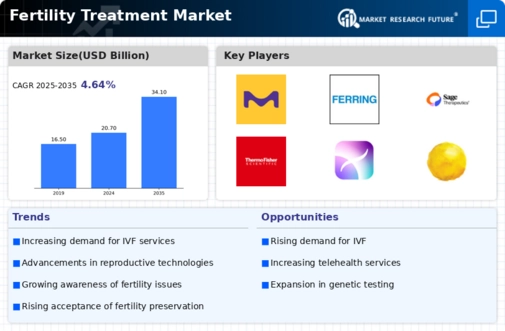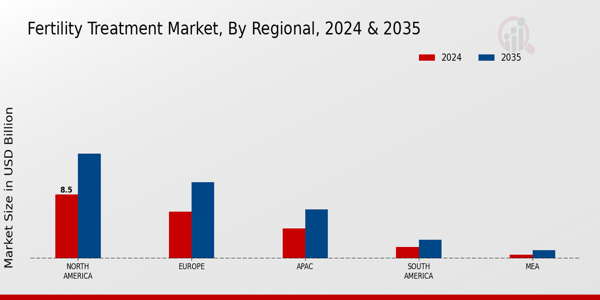-
EXECUTIVE SUMMARY
-
Market Overview
-
Key Findings
-
Market Segmentation
-
Competitive Landscape
-
Challenges and Opportunities
-
Future Outlook
-
MARKET INTRODUCTION
-
Definition
-
Scope of the study
- Research Objective
- Assumption
- Limitations
-
RESEARCH METHODOLOGY
-
Overview
-
Data Mining
-
Secondary Research
-
Primary Research
-
Primary Interviews and Information Gathering Process
-
Breakdown of Primary
-
Respondents
-
Forecasting Model
-
Market Size Estimation
-
Bottom-Up Approach
-
Top-Down Approach
-
Data Triangulation
-
Validation
-
MARKET DYNAMICS
-
Overview
-
Drivers
-
Restraints
-
Opportunities
-
MARKET FACTOR ANALYSIS
-
Value chain Analysis
-
Porter's Five Forces
-
Analysis
-
Bargaining Power of Suppliers
- Bargaining Power
-
of Buyers
-
Threat of New Entrants
- Threat of Substitutes
- Intensity of Rivalry
-
COVID-19 Impact Analysis
-
Market Impact Analysis
-
Regional Impact
- Opportunity and
-
Threat Analysis
-
FERTILITY TREATMENT MARKET, BY TREATMENT
-
TYPE (USD BILLION)
-
In Vitro Fertilization
-
Intracytoplasmic
-
Sperm Injection
-
Artificial Insemination
-
Ovulation Induction
-
Fertility Preservation
-
FERTILITY TREATMENT MARKET, BY END USER
-
(USD BILLION)
-
Hospitals
-
Fertility Clinics
-
Research
-
Institutions
-
Home Care
-
FERTILITY TREATMENT MARKET, BY PROCEDURE
-
(USD BILLION)
-
Surgical Procedures
-
Non-Surgical Procedures
-
FERTILITY TREATMENT MARKET, BY GENDER (USD BILLION)
-
Male
-
Female
-
Couples
-
FERTILITY TREATMENT MARKET, BY REGIONAL
-
(USD BILLION)
-
North America
- US
- Canada
-
Europe
- Germany
- UK
- France
-
Russia
-
Italy
- Spain
- Rest of Europe
-
APAC
- China
- India
- Japan
-
South Korea
-
Malaysia
- Thailand
- Indonesia
- Rest of APAC
-
South America
- Brazil
-
Mexico
-
Argentina
- Rest of South America
-
MEA
- GCC Countries
- South Africa
- Rest of MEA
-
COMPETITIVE LANDSCAPE
-
Overview
-
Competitive Analysis
-
Market share Analysis
-
Major Growth
-
Strategy in the Fertility Treatment Market
-
Competitive Benchmarking
-
Leading Players in Terms of Number of Developments in the Fertility
-
Treatment Market
-
Key developments and growth strategies
-
New Product Launch/Service Deployment
-
Merger & Acquisitions
- Joint Ventures
-
Major Players Financial Matrix
-
Sales and Operating Income
-
Major Players R&D Expenditure. 2023
-
COMPANY PROFILES
-
Merck KGaA
- Financial Overview
- Products Offered
- Key Developments
- SWOT
-
Analysis
-
Key Strategies
-
Ferring Pharmaceuticals
-
Financial Overview
-
Products Offered
- Key Developments
- SWOT Analysis
- Key Strategies
-
Irvine Scientific
- Financial Overview
- Products Offered
- Key
-
Developments
-
SWOT Analysis
- Key Strategies
-
SAGE Therapeutics
-
Financial Overview
- Products Offered
- Key Developments
- SWOT Analysis
- Key Strategies
-
Thermo Fisher Scientific
- Financial Overview
-
Products Offered
-
Key Developments
- SWOT Analysis
- Key Strategies
-
Allergan
- Financial Overview
- Products Offered
- Key Developments
- SWOT Analysis
- Key Strategies
-
Care Fertility
- Financial
-
Overview
-
Products Offered
- Key Developments
-
SWOT Analysis
-
Key Strategies
-
CooperSurgical
-
Financial Overview
-
Products Offered
- Key Developments
- SWOT Analysis
- Key Strategies
-
OvaScience
- Financial Overview
- Products Offered
- Key
-
Developments
-
SWOT Analysis
- Key Strategies
-
Vitrolife
-
Financial Overview
- Products Offered
- Key Developments
- SWOT Analysis
- Key Strategies
-
Reproductive Health Technologies
- Financial Overview
- Products Offered
- Key Developments
- SWOT
-
Analysis
-
Key Strategies
-
HRC Fertility
-
Financial Overview
-
Products Offered
- Key Developments
- SWOT Analysis
- Key Strategies
-
LifeQuest
- Financial Overview
- Products Offered
-
Key Developments
-
SWOT Analysis
- Key Strategies
-
Genea Limited
- Financial Overview
- Products
-
Offered
-
Key Developments
- SWOT Analysis
-
Key Strategies
-
Prelude Fertility
- Financial Overview
- Products Offered
- Key Developments
- SWOT
-
Analysis
-
Key Strategies
-
APPENDIX
-
References
-
Related Reports
-
BY TREATMENT TYPE, 2019-2035 (USD BILLIONS)
-
TREATMENT MARKET SIZE ESTIMATES & FORECAST, BY END USER, 2019-2035 (USD BILLIONS)
-
BY PROCEDURE, 2019-2035 (USD BILLIONS)
-
MARKET SIZE ESTIMATES & FORECAST, BY GENDER, 2019-2035 (USD BILLIONS)
-
NORTH AMERICA FERTILITY TREATMENT MARKET SIZE ESTIMATES & FORECAST, BY REGIONAL,
-
2035 (USD BILLIONS)
-
& FORECAST, BY TREATMENT TYPE, 2019-2035 (USD BILLIONS)
-
TREATMENT MARKET SIZE ESTIMATES & FORECAST, BY END USER, 2019-2035 (USD BILLIONS)
-
2035 (USD BILLIONS)
-
& FORECAST, BY GENDER, 2019-2035 (USD BILLIONS)
-
TREATMENT MARKET SIZE ESTIMATES & FORECAST, BY REGIONAL, 2019-2035 (USD BILLIONS)
-
BY TREATMENT TYPE, 2019-2035 (USD BILLIONS)
-
MARKET SIZE ESTIMATES & FORECAST, BY END USER, 2019-2035 (USD BILLIONS)
-
PROCEDURE, 2019-2035 (USD BILLIONS)
-
SIZE ESTIMATES & FORECAST, BY GENDER, 2019-2035 (USD BILLIONS)
-
CANADA FERTILITY TREATMENT MARKET SIZE ESTIMATES & FORECAST, BY REGIONAL, 2019-2035
-
(USD BILLIONS)
-
& FORECAST, BY TREATMENT TYPE, 2019-2035 (USD BILLIONS)
-
FERTILITY TREATMENT MARKET SIZE ESTIMATES & FORECAST, BY END USER, 2019-2035
-
(USD BILLIONS)
-
& FORECAST, BY PROCEDURE, 2019-2035 (USD BILLIONS)
-
TREATMENT MARKET SIZE ESTIMATES & FORECAST, BY GENDER, 2019-2035 (USD BILLIONS)
-
BY REGIONAL, 2019-2035 (USD BILLIONS)
-
MARKET SIZE ESTIMATES & FORECAST, BY TREATMENT TYPE, 2019-2035 (USD BILLIONS)
-
BY END USER, 2019-2035 (USD BILLIONS)
-
MARKET SIZE ESTIMATES & FORECAST, BY PROCEDURE, 2019-2035 (USD BILLIONS)
-
GENDER, 2019-2035 (USD BILLIONS)
-
SIZE ESTIMATES & FORECAST, BY REGIONAL, 2019-2035 (USD BILLIONS)
-
UK FERTILITY TREATMENT MARKET SIZE ESTIMATES & FORECAST, BY TREATMENT TYPE,
-
2035 (USD BILLIONS)
-
& FORECAST, BY END USER, 2019-2035 (USD BILLIONS)
-
TREATMENT MARKET SIZE ESTIMATES & FORECAST, BY PROCEDURE, 2019-2035 (USD BILLIONS)
-
GENDER, 2019-2035 (USD BILLIONS)
-
ESTIMATES & FORECAST, BY REGIONAL, 2019-2035 (USD BILLIONS)
-
FRANCE FERTILITY TREATMENT MARKET SIZE ESTIMATES & FORECAST, BY TREATMENT TYPE,
-
2035 (USD BILLIONS)
-
ESTIMATES & FORECAST, BY END USER, 2019-2035 (USD BILLIONS)
-
FRANCE FERTILITY TREATMENT MARKET SIZE ESTIMATES & FORECAST, BY PROCEDURE, 2019-2035
-
(USD BILLIONS)
-
& FORECAST, BY GENDER, 2019-2035 (USD BILLIONS)
-
TREATMENT MARKET SIZE ESTIMATES & FORECAST, BY REGIONAL, 2019-2035 (USD BILLIONS)
-
BY TREATMENT TYPE, 2019-2035 (USD BILLIONS)
-
MARKET SIZE ESTIMATES & FORECAST, BY END USER, 2019-2035 (USD BILLIONS)
-
PROCEDURE, 2019-2035 (USD BILLIONS)
-
SIZE ESTIMATES & FORECAST, BY GENDER, 2019-2035 (USD BILLIONS)
-
RUSSIA FERTILITY TREATMENT MARKET SIZE ESTIMATES & FORECAST, BY REGIONAL, 2019-2035
-
(USD BILLIONS)
-
FORECAST, BY TREATMENT TYPE, 2019-2035 (USD BILLIONS)
-
TREATMENT MARKET SIZE ESTIMATES & FORECAST, BY END USER, 2019-2035 (USD BILLIONS)
-
BY PROCEDURE, 2019-2035 (USD BILLIONS)
-
MARKET SIZE ESTIMATES & FORECAST, BY GENDER, 2019-2035 (USD BILLIONS)
-
ITALY FERTILITY TREATMENT MARKET SIZE ESTIMATES & FORECAST, BY REGIONAL,
-
2035 (USD BILLIONS)
-
& FORECAST, BY TREATMENT TYPE, 2019-2035 (USD BILLIONS)
-
FERTILITY TREATMENT MARKET SIZE ESTIMATES & FORECAST, BY END USER, 2019-2035
-
(USD BILLIONS)
-
FORECAST, BY PROCEDURE, 2019-2035 (USD BILLIONS)
-
TREATMENT MARKET SIZE ESTIMATES & FORECAST, BY GENDER, 2019-2035 (USD BILLIONS)
-
BY REGIONAL, 2019-2035 (USD BILLIONS)
-
MARKET SIZE ESTIMATES & FORECAST, BY TREATMENT TYPE, 2019-2035 (USD BILLIONS)
-
BY END USER, 2019-2035 (USD BILLIONS)
-
MARKET SIZE ESTIMATES & FORECAST, BY PROCEDURE, 2019-2035 (USD BILLIONS)
-
BY GENDER, 2019-2035 (USD BILLIONS)
-
MARKET SIZE ESTIMATES & FORECAST, BY REGIONAL, 2019-2035 (USD BILLIONS)
-
TYPE, 2019-2035 (USD BILLIONS)
-
ESTIMATES & FORECAST, BY END USER, 2019-2035 (USD BILLIONS)
-
APAC FERTILITY TREATMENT MARKET SIZE ESTIMATES & FORECAST, BY PROCEDURE, 2019-2035
-
(USD BILLIONS)
-
FORECAST, BY GENDER, 2019-2035 (USD BILLIONS)
-
MARKET SIZE ESTIMATES & FORECAST, BY REGIONAL, 2019-2035 (USD BILLIONS)
-
TYPE, 2019-2035 (USD BILLIONS)
-
SIZE ESTIMATES & FORECAST, BY END USER, 2019-2035 (USD BILLIONS)
-
CHINA FERTILITY TREATMENT MARKET SIZE ESTIMATES & FORECAST, BY PROCEDURE,
-
2035 (USD BILLIONS)
-
& FORECAST, BY GENDER, 2019-2035 (USD BILLIONS)
-
TREATMENT MARKET SIZE ESTIMATES & FORECAST, BY REGIONAL, 2019-2035 (USD BILLIONS)
-
BY TREATMENT TYPE, 2019-2035 (USD BILLIONS)
-
MARKET SIZE ESTIMATES & FORECAST, BY END USER, 2019-2035 (USD BILLIONS)
-
2035 (USD BILLIONS)
-
& FORECAST, BY GENDER, 2019-2035 (USD BILLIONS)
-
TREATMENT MARKET SIZE ESTIMATES & FORECAST, BY REGIONAL, 2019-2035 (USD BILLIONS)
-
BY TREATMENT TYPE, 2019-2035 (USD BILLIONS)
-
MARKET SIZE ESTIMATES & FORECAST, BY END USER, 2019-2035 (USD BILLIONS)
-
2035 (USD BILLIONS)
-
& FORECAST, BY GENDER, 2019-2035 (USD BILLIONS)
-
TREATMENT MARKET SIZE ESTIMATES & FORECAST, BY REGIONAL, 2019-2035 (USD BILLIONS)
-
BY TREATMENT TYPE, 2019-2035 (USD BILLIONS)
-
TREATMENT MARKET SIZE ESTIMATES & FORECAST, BY END USER, 2019-2035 (USD BILLIONS)
-
BY PROCEDURE, 2019-2035 (USD BILLIONS)
-
MARKET SIZE ESTIMATES & FORECAST, BY GENDER, 2019-2035 (USD BILLIONS)
-
SOUTH KOREA FERTILITY TREATMENT MARKET SIZE ESTIMATES & FORECAST, BY REGIONAL,
-
2035 (USD BILLIONS)
-
ESTIMATES & FORECAST, BY TREATMENT TYPE, 2019-2035 (USD BILLIONS)
-
MALAYSIA FERTILITY TREATMENT MARKET SIZE ESTIMATES & FORECAST, BY END USER,
-
2035 (USD BILLIONS)
-
ESTIMATES & FORECAST, BY PROCEDURE, 2019-2035 (USD BILLIONS)
-
MALAYSIA FERTILITY TREATMENT MARKET SIZE ESTIMATES & FORECAST, BY GENDER, 2019-2035
-
(USD BILLIONS)
-
& FORECAST, BY REGIONAL, 2019-2035 (USD BILLIONS)
-
TREATMENT MARKET SIZE ESTIMATES & FORECAST, BY TREATMENT TYPE, 2019-2035 (USD
-
BILLIONS)
-
FORECAST, BY END USER, 2019-2035 (USD BILLIONS)
-
TREATMENT MARKET SIZE ESTIMATES & FORECAST, BY PROCEDURE, 2019-2035 (USD BILLIONS)
-
BY GENDER, 2019-2035 (USD BILLIONS)
-
MARKET SIZE ESTIMATES & FORECAST, BY REGIONAL, 2019-2035 (USD BILLIONS)
-
BY TREATMENT TYPE, 2019-2035 (USD BILLIONS)
-
TREATMENT MARKET SIZE ESTIMATES & FORECAST, BY END USER, 2019-2035 (USD BILLIONS)
-
BY PROCEDURE, 2019-2035 (USD BILLIONS)
-
MARKET SIZE ESTIMATES & FORECAST, BY GENDER, 2019-2035 (USD BILLIONS)
-
INDONESIA FERTILITY TREATMENT MARKET SIZE ESTIMATES & FORECAST, BY REGIONAL,
-
2035 (USD BILLIONS)
-
SIZE ESTIMATES & FORECAST, BY TREATMENT TYPE, 2019-2035 (USD BILLIONS)
-
REST OF APAC FERTILITY TREATMENT MARKET SIZE ESTIMATES & FORECAST, BY END
-
USER, 2019-2035 (USD BILLIONS)
-
MARKET SIZE ESTIMATES & FORECAST, BY PROCEDURE, 2019-2035 (USD BILLIONS)
-
BY GENDER, 2019-2035 (USD BILLIONS)
-
MARKET SIZE ESTIMATES & FORECAST, BY REGIONAL, 2019-2035 (USD BILLIONS)
-
BY TREATMENT TYPE, 2019-2035 (USD BILLIONS)
-
TREATMENT MARKET SIZE ESTIMATES & FORECAST, BY END USER, 2019-2035 (USD BILLIONS)
-
BY PROCEDURE, 2019-2035 (USD BILLIONS)
-
TREATMENT MARKET SIZE ESTIMATES & FORECAST, BY GENDER, 2019-2035 (USD BILLIONS)
-
BY REGIONAL, 2019-2035 (USD BILLIONS)
-
MARKET SIZE ESTIMATES & FORECAST, BY TREATMENT TYPE, 2019-2035 (USD BILLIONS)
-
BY END USER, 2019-2035 (USD BILLIONS)
-
MARKET SIZE ESTIMATES & FORECAST, BY PROCEDURE, 2019-2035 (USD BILLIONS)
-
GENDER, 2019-2035 (USD BILLIONS)
-
SIZE ESTIMATES & FORECAST, BY REGIONAL, 2019-2035 (USD BILLIONS)
-
MEXICO FERTILITY TREATMENT MARKET SIZE ESTIMATES & FORECAST, BY TREATMENT
-
TYPE, 2019-2035 (USD BILLIONS)
-
SIZE ESTIMATES & FORECAST, BY END USER, 2019-2035 (USD BILLIONS)
-
MEXICO FERTILITY TREATMENT MARKET SIZE ESTIMATES & FORECAST, BY PROCEDURE,
-
2035 (USD BILLIONS)
-
ESTIMATES & FORECAST, BY GENDER, 2019-2035 (USD BILLIONS)
-
FERTILITY TREATMENT MARKET SIZE ESTIMATES & FORECAST, BY REGIONAL, 2019-2035
-
(USD BILLIONS)
-
& FORECAST, BY TREATMENT TYPE, 2019-2035 (USD BILLIONS)
-
FERTILITY TREATMENT MARKET SIZE ESTIMATES & FORECAST, BY END USER, 2019-2035
-
(USD BILLIONS)
-
& FORECAST, BY PROCEDURE, 2019-2035 (USD BILLIONS)
-
FERTILITY TREATMENT MARKET SIZE ESTIMATES & FORECAST, BY GENDER, 2019-2035 (USD
-
BILLIONS)
-
FORECAST, BY REGIONAL, 2019-2035 (USD BILLIONS)
-
FERTILITY TREATMENT MARKET SIZE ESTIMATES & FORECAST, BY TREATMENT TYPE, 2019-2035
-
(USD BILLIONS)
-
SIZE ESTIMATES & FORECAST, BY END USER, 2019-2035 (USD BILLIONS)
-
REST OF SOUTH AMERICA FERTILITY TREATMENT MARKET SIZE ESTIMATES & FORECAST,
-
BY PROCEDURE, 2019-2035 (USD BILLIONS)
-
TREATMENT MARKET SIZE ESTIMATES & FORECAST, BY GENDER, 2019-2035 (USD BILLIONS)
-
& FORECAST, BY REGIONAL, 2019-2035 (USD BILLIONS)
-
TREATMENT MARKET SIZE ESTIMATES & FORECAST, BY TREATMENT TYPE, 2019-2035 (USD
-
BILLIONS)
-
BY END USER, 2019-2035 (USD BILLIONS)
-
SIZE ESTIMATES & FORECAST, BY PROCEDURE, 2019-2035 (USD BILLIONS)
-
MEA FERTILITY TREATMENT MARKET SIZE ESTIMATES & FORECAST, BY GENDER, 2019-2035
-
(USD BILLIONS)
-
FORECAST, BY REGIONAL, 2019-2035 (USD BILLIONS)
-
TREATMENT MARKET SIZE ESTIMATES & FORECAST, BY TREATMENT TYPE, 2019-2035 (USD
-
BILLIONS)
-
& FORECAST, BY END USER, 2019-2035 (USD BILLIONS)
-
FERTILITY TREATMENT MARKET SIZE ESTIMATES & FORECAST, BY PROCEDURE, 2019-2035
-
(USD BILLIONS)
-
& FORECAST, BY GENDER, 2019-2035 (USD BILLIONS)
-
FERTILITY TREATMENT MARKET SIZE ESTIMATES & FORECAST, BY REGIONAL, 2019-2035
-
(USD BILLIONS)
-
& FORECAST, BY TREATMENT TYPE, 2019-2035 (USD BILLIONS)
-
AFRICA FERTILITY TREATMENT MARKET SIZE ESTIMATES & FORECAST, BY END USER, 2019-2035
-
(USD BILLIONS)
-
& FORECAST, BY PROCEDURE, 2019-2035 (USD BILLIONS)
-
FERTILITY TREATMENT MARKET SIZE ESTIMATES & FORECAST, BY GENDER, 2019-2035 (USD
-
BILLIONS)
-
& FORECAST, BY REGIONAL, 2019-2035 (USD BILLIONS)
-
FERTILITY TREATMENT MARKET SIZE ESTIMATES & FORECAST, BY TREATMENT TYPE, 2019-2035
-
(USD BILLIONS)
-
& FORECAST, BY END USER, 2019-2035 (USD BILLIONS)
-
FERTILITY TREATMENT MARKET SIZE ESTIMATES & FORECAST, BY PROCEDURE, 2019-2035
-
(USD BILLIONS)
-
& FORECAST, BY GENDER, 2019-2035 (USD BILLIONS)
-
FERTILITY TREATMENT MARKET SIZE ESTIMATES & FORECAST, BY REGIONAL, 2019-2035
-
(USD BILLIONS)
-
MARKET SYNOPSIS
-
US FERTILITY TREATMENT MARKET ANALYSIS BY END USER
-
TREATMENT MARKET ANALYSIS BY PROCEDURE
-
ANALYSIS BY GENDER
-
CANADA FERTILITY TREATMENT MARKET ANALYSIS BY PROCEDURE
-
FERTILITY TREATMENT MARKET ANALYSIS BY GENDER
-
TREATMENT MARKET ANALYSIS BY REGIONAL
-
MARKET ANALYSIS
-
TREATMENT TYPE
-
USER
-
GERMANY FERTILITY TREATMENT MARKET ANALYSIS BY REGIONAL
-
FERTILITY TREATMENT MARKET ANALYSIS BY TREATMENT TYPE
-
TREATMENT MARKET ANALYSIS BY END USER
-
ANALYSIS BY PROCEDURE
-
GENDER
-
FRANCE FERTILITY TREATMENT MARKET ANALYSIS BY TREATMENT TYPE
-
FRANCE FERTILITY TREATMENT MARKET ANALYSIS BY END USER
-
TREATMENT MARKET ANALYSIS BY PROCEDURE
-
MARKET ANALYSIS BY GENDER
-
BY REGIONAL
-
TYPE
-
RUSSIA FERTILITY TREATMENT MARKET ANALYSIS BY GENDER
-
FERTILITY TREATMENT MARKET ANALYSIS BY REGIONAL
-
TREATMENT MARKET ANALYSIS BY TREATMENT TYPE
-
MARKET ANALYSIS BY END USER
-
BY PROCEDURE
-
SPAIN FERTILITY TREATMENT MARKET ANALYSIS BY TREATMENT TYPE
-
SPAIN FERTILITY TREATMENT MARKET ANALYSIS BY END USER
-
TREATMENT MARKET ANALYSIS BY PROCEDURE
-
MARKET ANALYSIS BY GENDER
-
BY REGIONAL
-
BY TREATMENT TYPE
-
BY END USER
-
BY PROCEDURE
-
BY GENDER
-
REGIONAL
-
CHINA FERTILITY TREATMENT MARKET ANALYSIS BY TREATMENT TYPE
-
CHINA FERTILITY TREATMENT MARKET ANALYSIS BY END USER
-
TREATMENT MARKET ANALYSIS BY PROCEDURE
-
MARKET ANALYSIS BY GENDER
-
BY REGIONAL
-
TYPE
-
INDIA FERTILITY TREATMENT MARKET ANALYSIS BY GENDER
-
TREATMENT MARKET ANALYSIS BY REGIONAL
-
MARKET ANALYSIS BY TREATMENT TYPE
-
ANALYSIS BY END USER
-
BY PROCEDURE
-
SOUTH KOREA FERTILITY TREATMENT MARKET ANALYSIS BY TREATMENT TYPE
-
SOUTH KOREA FERTILITY TREATMENT MARKET ANALYSIS BY END USER
-
SOUTH KOREA FERTILITY TREATMENT MARKET ANALYSIS BY PROCEDURE
-
KOREA FERTILITY TREATMENT MARKET ANALYSIS BY GENDER
-
FERTILITY TREATMENT MARKET ANALYSIS BY REGIONAL
-
TREATMENT MARKET ANALYSIS BY TREATMENT TYPE
-
TREATMENT MARKET ANALYSIS BY END USER
-
MARKET ANALYSIS BY PROCEDURE
-
ANALYSIS BY GENDER
-
BY REGIONAL
-
TYPE
-
THAILAND FERTILITY TREATMENT MARKET ANALYSIS BY GENDER
-
FERTILITY TREATMENT MARKET ANALYSIS BY REGIONAL
-
TREATMENT MARKET ANALYSIS BY TREATMENT TYPE
-
TREATMENT MARKET ANALYSIS BY END USER
-
MARKET ANALYSIS BY PROCEDURE
-
ANALYSIS BY GENDER
-
BY REGIONAL
-
TREATMENT TYPE
-
BY END USER
-
PROCEDURE
-
BRAZIL FERTILITY TREATMENT MARKET ANALYSIS BY TREATMENT TYPE
-
FERTILITY TREATMENT MARKET ANALYSIS BY END USER
-
TREATMENT MARKET ANALYSIS BY PROCEDURE
-
MARKET ANALYSIS BY GENDER
-
BY REGIONAL
-
TYPE
-
MEXICO FERTILITY TREATMENT MARKET ANALYSIS BY GENDER
-
FERTILITY TREATMENT MARKET ANALYSIS BY REGIONAL
-
TREATMENT MARKET ANALYSIS BY TREATMENT TYPE
-
TREATMENT MARKET ANALYSIS BY END USER
-
MARKET ANALYSIS BY PROCEDURE
-
ANALYSIS BY GENDER
-
BY REGIONAL
-
BY TREATMENT TYPE
-
ANALYSIS BY END USER
-
MARKET ANALYSIS BY PROCEDURE
-
MARKET ANALYSIS BY GENDER
-
MARKET ANALYSIS BY REGIONAL
-
TYPE
-
USER
-
SOUTH AFRICA FERTILITY TREATMENT MARKET ANALYSIS BY REGIONAL
-
REST OF MEA FERTILITY TREATMENT MARKET ANALYSIS BY TREATMENT TYPE
-
REST OF MEA FERTILITY TREATMENT MARKET ANALYSIS BY END USER
-
OF MEA FERTILITY TREATMENT MARKET ANALYSIS BY PROCEDURE
-
MEA FERTILITY TREATMENT MARKET ANALYSIS BY GENDER
-
FERTILITY TREATMENT MARKET ANALYSIS BY REGIONAL
-
OF FERTILITY TREATMENT MARKET
-
DRO ANALYSIS OF FERTILITY TREATMENT MARKET
-
ANALYSIS: FERTILITY TREATMENT MARKET
-
FERTILITY TREATMENT MARKET
-
MARKET
-
SHARE)
-
(USD Billions)
-
(% SHARE)
-
(USD Billions)
-
(% SHARE)
-
(USD Billions)
-
SHARE)
-
Billions)












